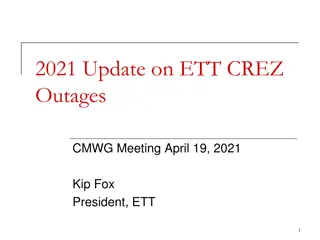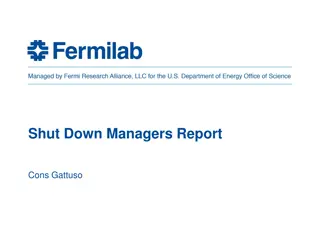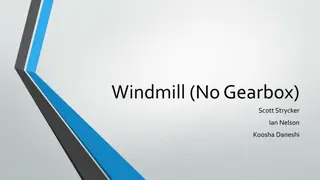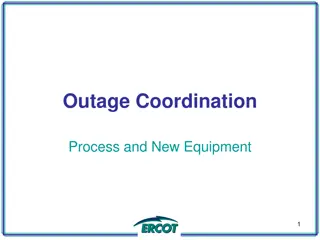Understanding Power Outages and Generators: What You Need to Know
Learn about the causes of power outages, types of generators, and essential factors to consider when selecting the best option for your needs. Explore insights on weather-related causes, high power demand, aging infrastructure, notable cyber attacks, and more. Stay informed to make informed decisions for managing emergencies and ensuring power supply reliability.
Uploaded on Oct 05, 2024 | 0 Views
Download Presentation

Please find below an Image/Link to download the presentation.
The content on the website is provided AS IS for your information and personal use only. It may not be sold, licensed, or shared on other websites without obtaining consent from the author. Download presentation by click this link. If you encounter any issues during the download, it is possible that the publisher has removed the file from their server.
E N D
Presentation Transcript
EMERGENCY GENERATORS GWINNETT AMATEUR RADIO SOCIETY SEPTEMBER 21, 2021
GENERATORS What You Need To Know To Select The Best Option For You What causes power outages? Type of fuel to use Types of generators Generator size Operations & Safety Costs
U.S. POWER OUTAGES IN MILLIONS OF HOURS Simple Math 1.33B Hours Divided by 128M Households = 10.4 Hr. Avg. 1.48 Billion Hours 1.33 Billion Hours Most outages will only last a day or two, but some will last a couple of weeks 770 Million Hours
WHAT CAUSES POWER OUTAGES? Weather High Power Demand Aging Transmission Lines Cyber Attacks EMP Coronal Mass Ejection Construction Digging Animals Up to 30% of Power Outages are due to squirrels
WEATHER RELATED CAUSES Wildfires & Extreme Heat 2% Tornadoes 3% Hurricanes & Tropical Storms 18% Storms & Severe Weather 57% Cold Weather & Ice Storms 20%
HIGH POWER DEMAND Georgia Power offers a phone app to track capacity & demand
The American Society of Civil Engineers report that many electric transmission and distributions lines were constructed in the 1950s and 1960s with a 50-year life expectancy. The average age is 40 years and 25% are age 50 or more Dr. Joshua Rhodes of the University of Texas Energy Research Department estimates replacement cost to be 1.5 2 Trillion dollars. The Infrastructure Bill includes $73 Billion
NOTABLE POWER GRID CYBER ATTACKS 2015 & 2016 Kiev Ukraine attack by Russia 2017 Saudi Arabia oil fields attacked by Iran 2017 Burlington Vermont by Russia 2019 Russia attack by ??? 2020 European Union Successful Cyber Intrusion 2021 - Mumbai India attack by China
CONVENTIONAL VS INVERTER INVERTER CONVENTIONAL Invented in 1831 by Faraday Produces one block wave of AC power for each rotation of the generator To produce US standard 120V/60Hz it must turn at a constant 3600rpm Invented in 1987 by Honda Step 1 produces AC power which is converted to DC Step 2 an electronic inverter converts it back to 120v/60Hz AC power This produces a pure sine wave with less harmonic distortion
WHAT DIFFERENCE DOES IT MAKE? Feature Conventional Inverter Fuel Cost Efficiency Power Cost Noise Better Not as Good
COMPARISON INVERTER CONVENTIONAL Straight AC power Available 700 150,000 watts Runs full throttle Significantly less initial cost for equal power output Less complex AC converted to DC inverted to AC Available 1000 7000 watts Variable Speed based on load Quieter Smaller & lighter Clean, consistent power Can be run in parallel More expensive
WHICH IS BEST? Depends on your use and budget
WHICH TYPE FUEL ? Gasoline Diesel Natural Gas Liquid Petroleum Gas (LPG)/Propane Dual Fuel (Gasoline or Propane) Multiple Fuel (Gasoline / Propane / Natural Gas )
GASOLINE POWER CON PRO Refueling danger due to spillage on a hot engine Fuel storage fire issues Fuel degrades over time E0 gas hard to find, E10 gas gunks up the carburetor Constant 3600 rpm speed Lowest initial Cost Wide availability
DIESEL FUEL PRO CON Long standing proven technology Runs at 1800 rpms instead of 3600 rpms Longer run time & durability Low storage fire risk Higher initial costs Diesel degrades over time Emission regulations require ultra-low sulfur diesel which is less stable Rising fuel costs
LPG/PROPANE PRO CON Constant 3600 rpm run speed Power output less than a gas or diesel fueled generator Fuel tanks only filled to 80% capacity Fuel stored on site Unlimited shelf-life Runs clean without carburetor fouling
NATURAL GAS PRO No fuel storage issues No refueling issues Low fuel costs Some run at 1800 rpms other at 3600 rpms CON Fuel supply delivery outside your control In an emergency delivery is subject to prioritization and containment
DUAL & MULTI-FUEL PRO Take advantage of preferred fuel type, with a back-up capacity if that fuel is unavailable Better manage refueling issues CON Higher initial cost Power is 10% less when running on natural gas or propane Storing multiple fuels more complex
COMPARING FUEL COSTS Factor Gasoline Diesel Propane Natural Gas 22kW Generator Size Unit Cost 5 kW 20kW 20kW $2.98/gal $3.15/gal $2.75/gal $0.65/ccf Use/Hr. 0.75 gal 1.6 gal 1.89 gal 2.28ccf Cost/Hr. $2.24 $5.04 $5.20 $1.48 Cost/Day $53.64 $120.96 $124.74 $35.57 Cost/kWh $0.45 $0.25 $0.26 $0.07
SIZING YOUR GENERATOR Make a list of the items that need to be powered by the generator. Make a note of the running and starting wattage of the respective items. Total the wattage requirements using the starting wattage for items that require them. Allow at least 25% above the running wattage total Note best fuel efficiency is running at 50% load
EXAMPLES TO CONSIDER Basic Items Optional Items Running Watts Starting Watts Laptop 200 watt Refrigerator w/freezer 700 2200 10,000 BTU Room A/C 1200/3600 Deep Freezer 500 1500 Box Fan 200 Six 75w light bulbs 450 Microwave 1200 Radio 30A power supply 300 Coffee Maker 1000 Phone charger 20 Space Heater 1800 TOTAL Needed 4470 Watts TV 27 500 DVD 100
SMALL INVERTOR 2000W CHOOSE WHAT YOU CAN RUN Basic Items Optional Items Running Watts Starting Watts Laptop 200 watt Refrigerator w/freezer 700 2200 10,000 BTU Window A/C 1200/3600 Deep Freezer 500 1500 Box Fan 200 Six 75w light bulbs 450 Microwave 1200 Radio 30A power supply 300 Coffee Maker 1000 Phone charger 20 Space Heater 1800 TOTAL Needed 4470 Watts TV 27 500 DVD 100
MEDIUM GENERATOR 4500W CHOOSE WHAT YOU CAN RUN Basic Items Optional Items Running Watts Starting Watts Laptop 200 watt Refrigerator w/freezer 700 2200 10,000 BTU Window A/C 1200/3600 Deep Freezer 500 1500 Box Fan 200 Six 75w light bulbs 450 Microwave 1200 Radio 30A power supply 300 Coffee Maker 1000 Phone charger 20 Space Heater 1800 TOTAL Needed 4470 Watts TV 27 500 DVD 100
LARGER GENERATOR 7000W CHOOSE WHAT YOU CAN RUN Basic Items Optional Items Running Watts Starting Watts Laptop 200 watt Refrigerator w/freezer 700 2200 10,000 BTU Window A/C 1200/3600 Deep Freezer 500 1500 Box Fan 200 Six 75w light bulbs 450 Microwave 1200 Radio 30A power supply 300 Coffee Maker 1000 Phone charger 20 Space Heater 1800 TOTAL Needed 4470 Watts TV 27 500 DVD 100
SHOULD PORTABLE GENERATOR BE GROUNDED OSHA states the frame of a portable generator need not be grounded (connected to earth) and that the frame may serve as the ground (in place of the earth), IF The noncurrent carrying metal parts of equipment are bonded to the generator frame AND the equipment grounding conductor terminals that are part of the generator are bonded to the generator frame. 1926.404(f)(3)(i)(B) The generator supplies only equipment cord and plug connected equipment through receptacles mounted on the generator 1926.404(f)(3)(i)(A)
DEVICE REQUIREMENTS & MAX CORD LENGTH BY WIRE GAUGE Amps Watts #10 #12 #14 #16 10A 1200 250 150 100 50 20A 2400 125 75 50 - 30A 3600 65 - - - Make Sure the Power Cord is Rated for Outdoor Use
HOW TO RUN YOUR POWER CORDS THROUGH THE WINDOW Temporary Power outlet Cut a notch in a board Sized to fit the power cord Cut the board To fit the window
KEEP THE GENERATOR DRY Keep outlets 100% dry Maintain air flow Be sure the enclosure can handle the elements and wind
GASOLINE REFUELING SAFETY Turn the generator off and let it cool for 2 minutes before taking off the gas cap Do not let gas spill on the hot engine Do not overfill
CONNECTING TO THE GENERATOR 1. Start the generator 2. Allow it to run for 2-5 minutes to stabilize 3. Plug in the highest draw item 4. Allow the engine to stabilize 5. Repeat plugging in one item at a time, followed by allowing the engine to stabilize
STOPPING THE GENERATOR 1. Turn off and unplug each electric load, one at time 2. Run the generator at no load for several minutes 3. Turn off the fuel valve until fuel starvation has stopped the engine 4. Turn off the engine switch Continue if a gasoline engine 5. Remove the spark plug cap 6. Crank the engine to drain any gasoline from the carburetor jets 7. Clean the carburetor 8. Drain the fuel tank
PORTABLE GENERATOR RUN TIME Generator will last for 1000 to 2000 hours before engine replacement Continuous run time limited to 6-12 hours, before you must let it cool down One option is to have 2 generators and switch back and forth every 8 hours.
HOME STANDBY GENERATORS Air Cooled Critical Circuits 7.5 15kW Air Cooled Whole House 17 22kW Liquid Cooled Whole House 24 60kW Liquid Cooled Generators Cost $10K Extra Requires a Manual or Auto Transfer Switch
HOME GENERATOR DETAILS Allow extended run time Can run your whole house or only critical circuits May Include your A/C Requires a starting battery Maybe air cooler or water-cooling Requires a transfer switch which must be installed by a licensed electrician
AUTO TRANSFER SWITCH 1. ATS detects utility outage 2. IF power still out after 10 seconds, auto engine start 3. Engine warms for 5 - 20 seconds, depending on temperature 4. Generator starts and is at full capacity in 5 seconds 5. ATS switches to generator power
IMPACT OF LOAD ON FUEL COSTS GEORGIA NATURAL GAS FOR 22KW GENERATOR Fuel Consumption Per Hour Cost Cost Cost Per Hr. Per Day 17 Days* 12 mo. fixed Cost/therm Load 228cft. $1.42 $34.08 $579.36 $.65 $.65 Full Load 309cft. $2.01 $48.20 $819.40 * Texas Snowmageddon = 17 days
Generac Kohler Cummins Briggs & Stratton 7.5kW 10kW 10kW 10kW Available Sizes By Brand 12kW 13kW 12kW 14kW 14kW 15kW 18kW 17kW 20kW 20kW 20kW 20kW Google Generator Calculator to determine operating size 22kW 24kW 24kW 25kW 25kW 27kW 30kW 30kW 30kW 30kW 32kW Air Cooled Critical Circuit Air Cooled Whole House Liquid Cooled Whole House 36kW 38kW 38kW 45kw 48kW 48kW 60kW 60kW
NOISE LEVEL Home Standby Generators Are Rated at 64dB to 69dB At 21 feet 70 dB is 10 Times Louder than 60 dB
GENERATOR PLACEMENT Must be 5 feet from a window Must be 5 feet from the gas meter Distance between generator, gas meter and breaker box is a major factor in installation costs Gas line must be 1 or larger Noise level factors (distance to neighbors, brick vs shrubs) Is gas meter near electric meter?
WHOLE HOUSE GENERATOR MAINTENANCE Bi-Weekly Auto Test Run Programmed to run at day/time certain to keep engine lubricated & battery tested Run Time 5 minutes 3600 rpm for 10 sec. 2400 rpm for 30 sec. 1800 rpm for 4 min. 20 sec. Run Time Maintenance After 200 hrs. run time Change oil & filter Check battery electrolyte level After 400 hrs. run time Change air filter Check sparkplug gaps or replace if necessary
BASIC PLANNING COSTS Installation Costs Major Factor GENERATOR Recreational Inverter Mid Size Inverter Large Inverter Portable Generator Home Standby Generator Diesel WATTAGE Up to 2000W Up to 3500W Up to 7000W Up to 7500W Up to 22Kw 10Kw-24Kw TYPICAL COST $650-$1500 $870-$1500 $1250-$4600 $790-$1400 $8000-$15,000 $15000-$25,000
What if you don t have a generator?























